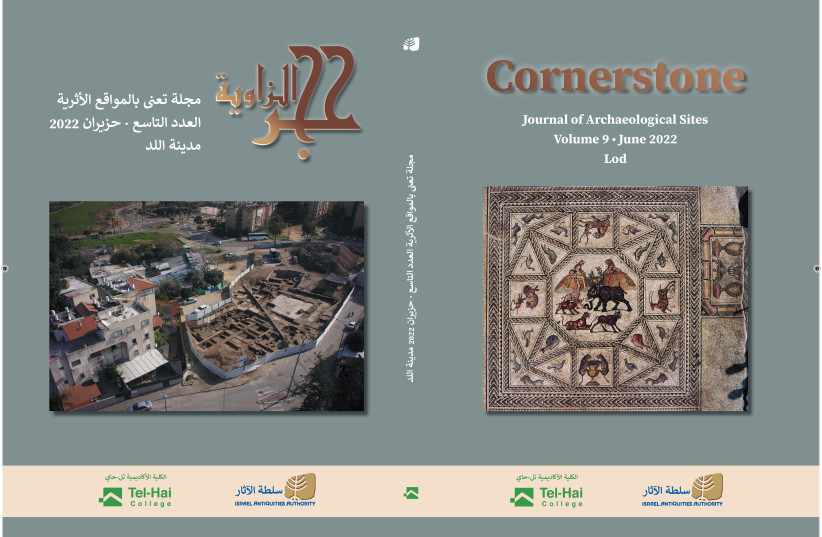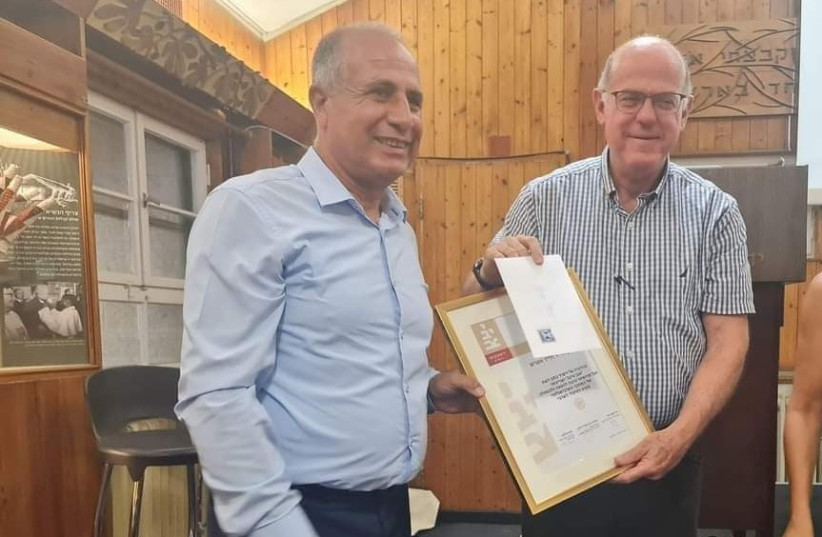The recent June issue of the Cornerstone archaeology journal is dedicated to the topic of the city of Lod. It includes articles on the famous Lod mosaic, about the city in prehistoric times, on how Lod/Lydda is represented in another famous mosaic – the Madaba Map, Roman-period coinage in Lod and a tale of two cities counter-positioning the rise of Ramle to the downfall of Lod.
And all of it is written in Arabic.
Called “Hajar Zawyia” in Arabic, the Israel Antiquities Authority journal edited by IAA senior archaeologist and co-founder Dr. Walid Atrash, is the only archaeological journal presenting archaeological research from Israel in Arabic.
Atrash was recently presented by the Yad Ben-Zvi research institute with its “Et-Mol” prize for the founding of the journal and its editing and contribution to sharing archaeological research from Israel among the Arab public.
So far eight issues have been published.

In awarding the prize Yad Ben-Zvi director Yaakov Yaani and editor of “Et-Mol” periodical Marva Balouka wrote: “The journal Cornerstone is very popular both in academia, in education and society, and among Arabic readers in Israel and abroad who are interested in the archaeology of the Land of Israel… they manage to reach places that other Israeli journals do not reach and present Israeli archaeology.
The establishment of the journal and its exposure to the Arab-speaking community is undoubtedly a revolution that promotes awareness of archaeology and heritage in the eyes of the Arab public.
Yaakov Yaani
The establishment of the journal and its exposure to the Arab-speaking community is undoubtedly a revolution that promotes awareness of archaeology and heritage in the eyes of the Arab public. The journal Cornerstone has the potential to become one of the most important “ambassadors” of Israeli archaeology and of the State of Israel in the world of Arabic and its speakers, and to bring these communities closer to Israeli archaeology.
“Dr. Walid Atrash and his team work to promote the journal with limited resources and hard work, volunteering and beyond their normal work.”
The journal was co-founded as a personal initiative by fellow IAA senior archaeologists Hamoudi Khalaily, a researcher of prehistory, and Kamil Sari, now senior archaeologist of the northern district, in 2018 under the academic sponsorship of Tel Hai College. The three volunteered their time first by translating the information put out by the IAA in Hebrew and English. As it grew the journal began accepting original submissions and was published through the help of various donations by private individuals and academic institutions. Following the awarding of the Yad Ben-Zvi prize the IAA has incorporated the journal as one of their official publications.
“We really saw the need to present the archaeological heritage in Israel to the Arabic world,” said Atrash. “There was a lack of information also in Arab schools in Israel. We decided it was up to us to present the knowledge, information and beauty of the sites and assets we have here to the Arab world and anyone who reads Arabic.”
More about the "Cornerstone" journal
THE ISSUES are distributed to libraries and research institutions in Israel and around the world, including American universities in the Arab world and researchers in the Arab world including the Palestinian Authority, Jordan, Egypt and Lebanon, and is available in both print and electronic forms.
Though archaeology is often a political land-mine in the region, Atrash said Cornerstone publishes only scientifically researched articles by recognized archaeology professionals, both local and international, Jewish and Arab.
“We do not mix politics or anything that can create a division, so we can gain the trust of the local Israeli and Arab world. We present research that really touches on the history of this land which is shared by the many nations who have passed through here from the Stone Age to the Ottoman period,” he said. “We have a range of researchers who write for us.”
Some of the articles are written directly in Arabic by Arab academics in Israeli institutions while others are translated into Arabic from Hebrew or English.
This prize exposed the journal to many people, Atrash said, noting it is happy for any support which helps maintain its publication. Most of the editing and graphic work is still done voluntarily by people dedicated to its publication, he said. They are also grateful to the IAA and the support of their endeavor by IAA Director-General Eli Eskosido, Atrash said.

Though some Arab institutions abroad have declined to receive the journal, Atrash prefers to concentrate on the positive responses such as a recent proposal from a Palestinian archaeology professor for a joint project connecting Israeli and Palestinian archaeologists.
“There really is no difference in the archaeology of Israel and the Palestinian Territories, and Jordan,” said Atrash. “From my point view this is a moving testimony of the success of our effort. The scientific content crosses borders and succeeds in leading to a real connection.”
Interest in information about local archaeology in Arabic has grown over the past decade, noted Khalaily, as more Arabs in Israel have begun to study archaeology and have entered the profession.
“Twenty years ago…anything having to do with archaeology was seen by the Arab population in Israel as more political than as heritage so there was no interest. In the last 10 years with more Arabs studying archaeology there has been a significant change and there is a thirst for information,” he said.
Being an international journal
The journal, which is available in printed form at Israeli academic institutions, including the Hebrew University, Tel Aviv University and Ben-Gurion University of the Negev has a partnership with Tel-Hai College where 50% of the student population is Arab and it is used as a basic teaching tool. It is also available to Arab-speaking tour guides from the Education Ministry.
Cornerstone also now has its own ISSN number, an internationally-recognized eight-digit serial number which is used to identify publications of all kinds in both print and electronic forms.
“This means we are internationally recognized as a serious international journal,” said Atrash.
“We are the bridge that connects between Israel and the Arabic world through archaeology”
Dr. Walid Atrash
“We are the bridge that connects between Israel and the Arabic world through archaeology.”
“People can connect to this. I am not saying there are not questions and that it is all utopia; there are concerns but we also receive positive responses,” said Khalaily.
For instance, with the Lod issue Arab-speaking residents of the city can not only see the physical building of the new Shelby White and Leon Levy Lod Mosaic Archaeological Center which is meant to benefit both the Arab and Jewish residents, but they can read in their own language about the history of their city from prehistoric times to the present, he said.
Despite the complicated nature of archaeology in the region, they are also not afraid of tackling the more thorny topics.
The next volume, Khalaily said, will be dedicated to Jerusalem.
